According to statistics, almost half of all dermatologists are associated with fungal disease in one way or another. When visiting the pool, you can receive infection while visiting the beach or visiting the master's slippers.
Learn all about how to identify fungi on the nail fungus on the legs without scratching and using other diagnostic methods - symptoms of dinoflagellosis manifestations in the initial and chronic stages of the disease.
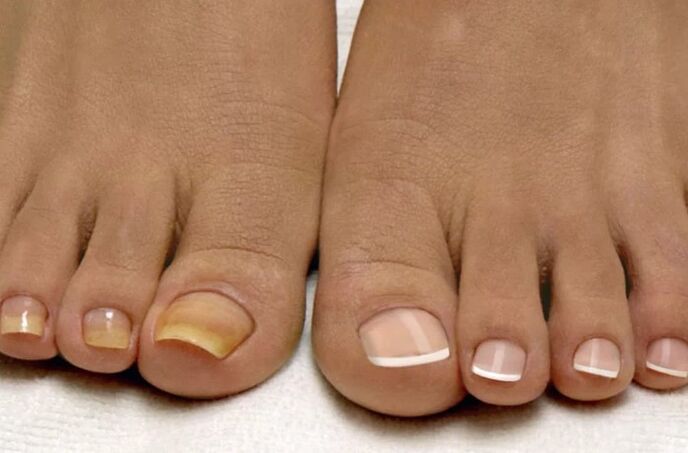
Many people don’t even doubt mediocre sweating on their legs, accompanied by an unpleasant odor, which is half the suffering of more than half of our planet’s population and one of the main symptoms of nail fungi. This disease has the risk of getting sick, at least some ignores personal hygiene.
The fungus of the nails are waiting anywhere, especially in places where public use is available. Worst of all, nail fungus is a rather sinister disease: it takes a long time to treat and is not always successful, as mycotic diseases tend to recur.
To identify the disease in time and start treatment, you should know all the signs of fungi on your legs.
How does the disease spread?
Infection is caused by parasitic fungi. The ideal environment for them to reproduce and develop is the added humidity combined with a warm atmosphere. It is generally believed that the main locations of bathrooms, saunas, water parks, swimming pools, manicure salons, etc. are the risk of high nail fungi.
However, the statistics completely refute these statements: If a family member has already encountered this problem, picking up nail fungi at home through common things (towels, shoes, clothes, carpets, showers or bathrooms), for example, he is on slippers (such as slippers raised by the owner (he doesn't even suspect the disease)).
But what factors affect the development of fungal diseases? Noting this basic moment, leading to infection with thyroxine:
- Decreased immunity;
- Damage to the nail plate;
- Violating blood circulation in the lower limbs, which may occur when wearing tight shoes;
- anatomical nature of foot pathology;
- Obesity;
- diabetes;
- Increase sweating.
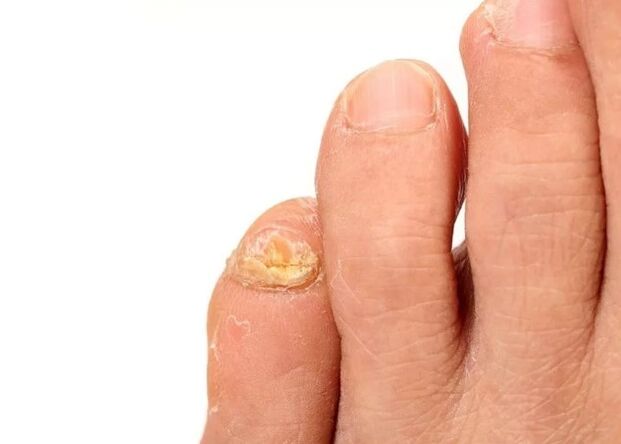
To at least partially protect yourself, you should use your stuff specifically, carefully treat the tub and shower with preservatives, use personal towels, regularly clean and wash carpets, paint shoes. To miss a moment that favors the treatment of mycotic diseases (after all, everyone knows that treatment is most effective in the early stages of disease development), you need to know the first sign of nail fungus.
Once you recognize the first sign of nail fungus, you should contact the expert who will prescribe the best treatment options right away.
How do different types of Onychomycosis behave?
Three types of Onychomycisos were identified, each showing its own signs.
You can determine the presence of fungi on your nails yourself, but only experts can determine the exact diagnosis. To do this, you need to visit the clinic to analyze the painful nails or scratches of the skin around you. Additionally, dermatologists prescribe microscopic or cultural studies.
Signs of disease pathogen fungi
The success of nail fungus treatment depends on the correct diagnosis of the pathogen. This is explained by the fact that the disease does not cause one kind of fungus, but several kinds of fungi, and each is sensitive to certain drugs. That is, if one fungus is resistant to one drug, another pathogen dies from the product.
More common causes of nail fungi:
- Yeast;
- Skin plants;
- Mold.
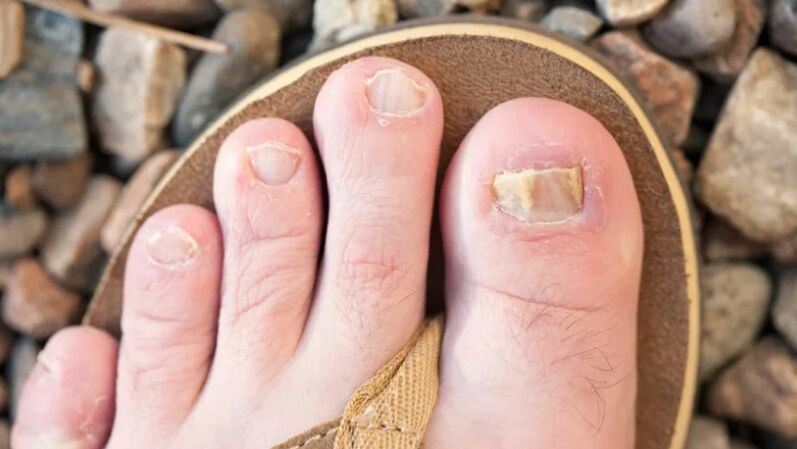
If nail fungi become yeast, it is almost impossible to identify the disease immediately. In this case, the signs of fungi on the leg nails are as follows (they appear after a long time): peeling of the nail plate and itchy skin near the nails (probably no itching). In 4-4. 5% of cases, yeast failure infection occurred.
Skin plants affect a person's nails more frequently than previous pathogens - this is 94. 5% of all the infections with fungal nails. There are three types of skin plants, each manifesting in a different way:
The last type of fungus is mold. Its pathogen is mold. The disease is found in only 1% of cases. Fungi from this species are frequently present in people infected with HIV.
Other Symptoms of Fungal Nail Infection
Usually at the beginning of the disease, there are no obvious signs of fungal nail damage. Be careful, however, you can notice some changes in the structure of your nails and their appearance.
As mentioned earlier, there may be longitudinal or round spots on the nail plate, and the nails may be like waves, while their smoothness and brilliance are lost.
Progress, disease increasingly destroys the nail plate: first, its shadow changes, and then the surface of the nail becomes scales, thickening or thickening, relaxing, breaking. The color of the nail depends on which fungus becomes the cause of the infection.
In addition to the main signs of tumoural disease, there are others:
- fragility of the edges of the nail plate or its entire surface;
- Deformation of nail shape, scaly structure of its structure;
- Nail writing stand;
- Cut nails under the skin;
- Malnutrition, lethargy, general weakness;
- The dish falls off the nail bed, causing patches to form under the white or yellow shaded nails with an unpleasant odor.
- Itching, rupture, and burning the skin near the affected nails;
- Malnutrition, lethargy, general weakness.
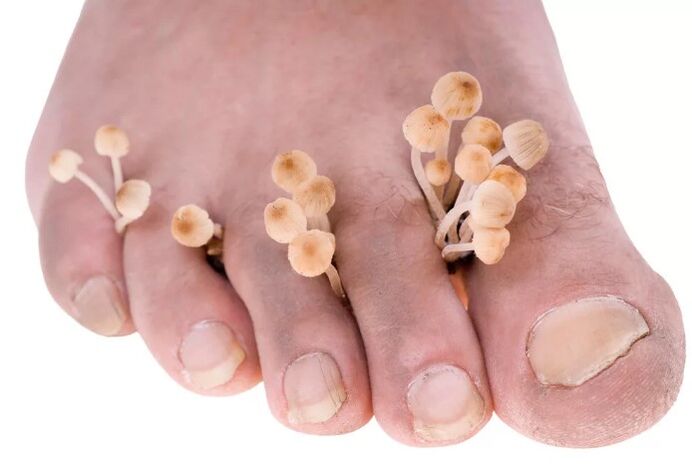
Any deviations in the appearance of nails on the legs should be kept vigilant as this may indicate the development of nail fungi. In this case, the first action is to travel to the dermatologist, who will confirm or refute your fears. If not immediately, the disease will progress.
At first glance, there is nothing wrong with this disease. However, besides pure aesthetic problems and discomfort, fungi can cause serious complications until suppurative infections in the affected areas, or even the development of gangrene.
Therefore, do not tighten during treatment and take immediate action as the disease is found.
What is nail fungus like
Every third person on Earth has a problem, such as layering and damage to nails, shadows of the plates - this is the tumor. The disease affects all ages. Nail fungus on the legs (photos are shown below), spreading rapidly and adapting to new conditions. We will consider the main factors in the occurrence, type and method of treating fungi in more detail.
What is nail fungus?
Onychomycisosis is the pathology that destroys the nail plate. Fungi Eats Custards - The architectural foundation of nails. The infection falls into the cell space and begins to divide. At the advanced stage, pathology can affect the skin, intermittent areas of the feet, and high heels.
Don't start fungi and treat them immediately
Causes of nail fungi
It is easy to get infected with thyroidoma. Infections may lurk on the beach, public souls, swimming pools. The possibility of capturing fungi from infected relatives or acquaintances (using shared life) is high.
There are several major prerequisites that can inspire viruses into the body:
- Weak immune system - reduced protection due to infectious or inflammatory diseases;
- Vascular pathology (venous occlusion) violates work of internal organs (diabetes), which leads to blood circulation problems in the lower limbs;
- The minor damage to the skin on the feet (abuses, microcracks, corn, corn) is caused by wearing tight shoes;
- Ignore diaper rash and heavy sweating in the lower limbs;
- Violated prudent measures - try someone else's shoes, visit public places without slippers, and ignore the hygiene of the legs.
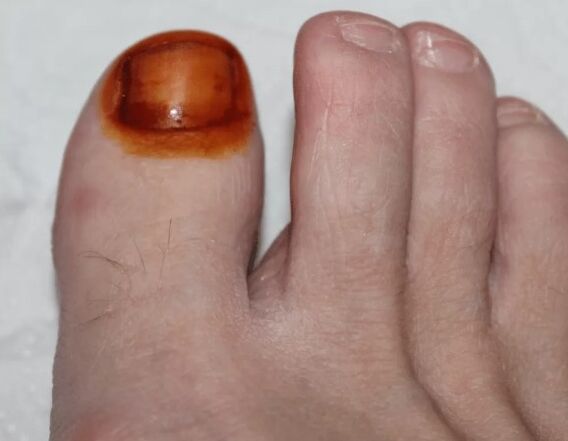
Types of nail fungi
Thyroid disease can cause several types of fungi. For example, skin plants appear in the form of clouds of nails. There are yellow spots formed on the edges or in the middle of the board. Additionally, longitudinal stripes along the region can be observed.
In the late stages of nail fungi, surgical intervention may be required
Yeast fungi can cause deformation of the nail plate. She was very delicate and began to leave her position and became gray. The metabolism in the damaged cells worsens and furrows appear on the nail roller. In addition, inflammation, edema, and redness appear on the adjacent epidermis, and the disappearance of the nail skin is observed.
If there is already a disease that causes nail nutrition disorders, mold can damage the nail plate. In this case, the plate also has shades, with its color variations (from light yellow and green to brown, even black).
To find out the causes and pathogens of negative changes in the skin and nails, you must contact an expert. Independent determination of the disease and its treatment without consulting a doctor may have consequences.
Folk Methods
Non-traditional agents can be used against fungal infections in the early stages of development. The following are the most effective:
- Apply iodine to the nail plate hit by mushrooms every morning and every day before bed until the symptoms completely disappear;
- Mix 3 tablespoons of water with one teaspoon of glycerin, vinegar and iodine. Nail composition for 10 days;
- Mix 9% vinegar with 1 to 8 water. Dear legs last for 20 minutes in the resulting liquid. Repeat the process every other day. There should be 7-10 in total;
- Place the raw eggs in a container and pour 9% vinegar. After the shell is completely dissolved, remove the remaining membrane and mix the vinegar with the egg. The solution was treated with fungal infection nails twice a day for 3 weeks;
- Dissolve 4 teaspoons of hydrogen peroxide in 2 liters of water. In the container, lower your feet and hold them for 20 minutes. The treatment process was 10 days;
- To moisten the cotton swab in the peroxide, secure it to the nails and be affected by a fungal infection. Before surgery, the legs should be steamed in a soda bath. Most importantly, the compression is wrapped in cellophane. Keep it for an hour. Treatment lasts for 2 weeks;
- Wet the cotton pad into 20% propolis tin and attach to the infected nails. Keep compressed until completely dry. The program is performed twice a day. Treatment continues until the symptoms of the disease completely disappear;
- Clean the cloves of garlic and cut it into the floor. Moisturize the salt and roast the nails thoroughly to them. Procedures were performed twice a day until the fungal characteristics completely disappeared;
- Add 2 teaspoons of ammonia to a cup of water. In solution, moisten the cotton pad, apply it to the fungus-affected nails, and leave it overnight. The treatment process was 7 days;
- Grind the onions thoroughly until they form dead. Apply the product to infected nail plates for half an hour. Treatment daily until full recovery;
- Grind mint, sage and chamomile have equal proportions. Pour medicinal plants into your toes and place them at night. Every day, the grass must be changed to fresh grass. This tool is used as a supplement to other methods.
- Take equal amounts of tea tree oil and tin. To soak the cotton pads at them, place them on infected nails for 45 minutes. The treatment process is 20 days. This tool is not allowed during pregnancy;
- In 500 ml of water, brew 6 teaspoons of nettle leaves. In the decoction, wet cotton wool place it on the nail plate with octa-myomycosis. Continue treatment until the symptoms completely disappear.
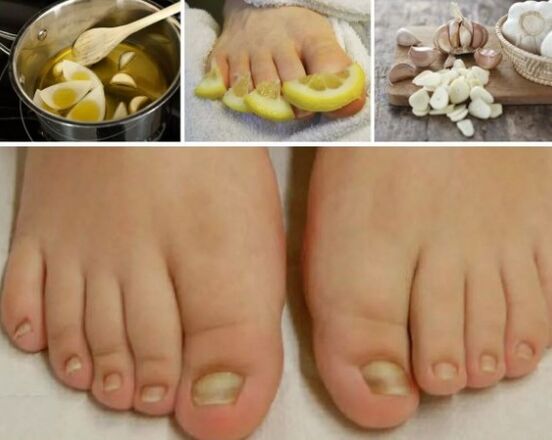
All folk remedies can only be used after consulting a dermatologist. Many of them are able to cause allergic reactions. Thyroxine can be cured more easily by combining non-traditional drugs with medications.
In the initial stages, the fungus on the legs looks like almost invisible grooves or white spots. Usually, a person can understand the presence of fungal infections only during a visit to a dermatologist. This is due to the fact that the disease is almost impossible to identify during this period. If you start treatment in time, the disease will be cured quickly.
















